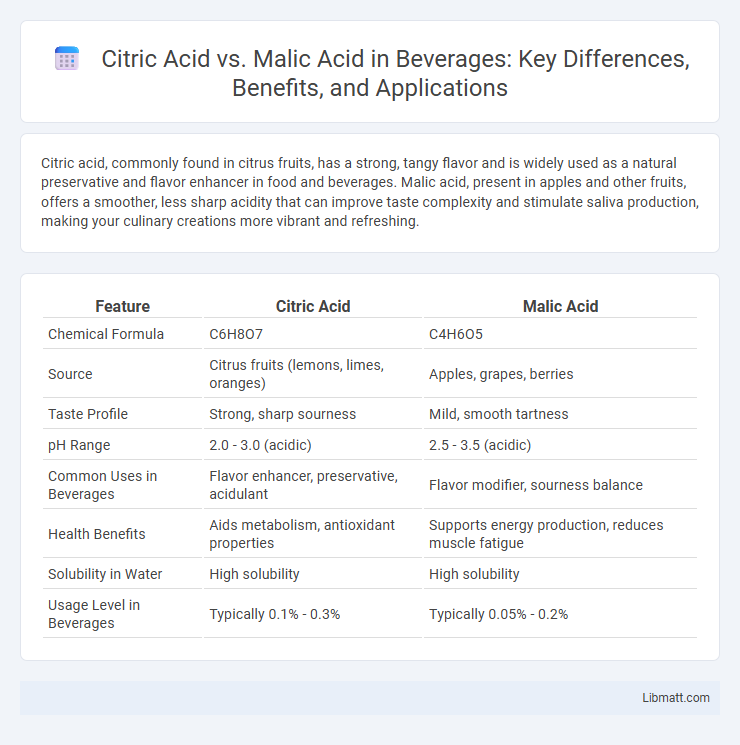Citric acid, commonly found in citrus fruits, has a strong, tangy flavor and is widely used as a natural preservative and flavor enhancer in food and beverages. Malic acid, present in apples and other fruits, offers a smoother, less sharp acidity that can improve taste complexity and stimulate saliva production, making your culinary creations more vibrant and refreshing.
Table of Comparison
| Feature | Citric Acid | Malic Acid |
|---|---|---|
| Chemical Formula | C6H8O7 | C4H6O5 |
| Source | Citrus fruits (lemons, limes, oranges) | Apples, grapes, berries |
| Taste Profile | Strong, sharp sourness | Mild, smooth tartness |
| pH Range | 2.0 - 3.0 (acidic) | 2.5 - 3.5 (acidic) |
| Common Uses in Beverages | Flavor enhancer, preservative, acidulant | Flavor modifier, sourness balance |
| Health Benefits | Aids metabolism, antioxidant properties | Supports energy production, reduces muscle fatigue |
| Solubility in Water | High solubility | High solubility |
| Usage Level in Beverages | Typically 0.1% - 0.3% | Typically 0.05% - 0.2% |
Introduction to Citric Acid and Malic Acid
Citric acid, a natural organic acid found in citrus fruits, plays a crucial role in the Krebs cycle for energy production in living organisms. Malic acid, present in apples and various other fruits, contributes to the sour taste and participates in the metabolic process of converting carbohydrates into energy. Your understanding of these organic acids enhances knowledge about their applications in food preservation, flavor enhancement, and health benefits.
Chemical Structures and Properties
Citric acid, a tricarboxylic acid with three carboxyl groups and one hydroxyl group, exhibits strong acidity and high solubility in water, making it a key intermediate in the Krebs cycle. Malic acid contains two carboxyl groups and one hydroxyl group, resulting in moderate acidity and a distinct sour taste commonly found in fruits like apples. The differing number and arrangement of carboxyl and hydroxyl groups influence their chemical reactivity, pKa values, and applications in food and pharmaceutical industries.
Natural Sources of Citric Acid and Malic Acid
Citric acid is predominantly found in citrus fruits such as lemons, limes, oranges, and grapefruits, where it contributes to their distinctive sour taste. Malic acid occurs naturally in fruits like apples, cherries, grapes, and pears, playing a key role in their tart flavor profiles. Both acids are integral to various metabolic processes in plants, with citric acid concentrated in citrus family fruits and malic acid more widely distributed in temperate fruits.
Flavor Profiles: Taste Differences
Citric acid delivers a bright, sharp citrus flavor commonly found in lemons and limes, producing a refreshing sourness that enhances beverages and desserts. Malic acid offers a smoother, slightly fruity tartness reminiscent of green apples, contributing to a more balanced and lingering acidity in food and drinks. Your choice between citric and malic acid depends on the desired intensity and complexity of sourness in your flavor profile.
Functional Roles in Food and Beverage Industry
Citric acid and malic acid serve crucial functional roles in the food and beverage industry, enhancing flavor, preservation, and acidity regulation. Citric acid is widely used for its strong tartness and natural antioxidant properties, improving shelf life in beverages, candies, and dairy products. Malic acid contributes a smoother, fruitier sourness, often preferred in fruit juices, wines, and confections to create balanced taste profiles that enhance Your product's sensory appeal.
Health Benefits and Potential Risks
Citric acid and malic acid both contribute to energy metabolism and antioxidant protection, with citric acid enhancing mineral absorption and malic acid supporting muscle performance. Excessive intake of citric acid may cause dental enamel erosion and gastrointestinal discomfort, while high doses of malic acid can lead to skin irritation or digestive upset. Understanding these health benefits and potential risks helps you choose the appropriate acid for supplements or dietary needs.
Uses in Skincare and Cosmetics
Citric acid is widely used in skincare for its exfoliating properties, helping to promote skin renewal and improve texture by adjusting the pH of formulations. Malic acid, often derived from apples, provides gentle exfoliation while enhancing hydration and skin brightness, making it suitable for sensitive skin types. Both acids function as natural alpha hydroxy acids (AHAs) and are commonly incorporated into anti-aging, brightening, and acne treatment products to improve overall skin appearance.
Industrial and Household Applications
Citric acid and malic acid serve crucial roles in industrial and household applications due to their organic acid properties. Citric acid is extensively used in food and beverage industries as a natural preservative, flavoring agent, and pH adjuster, while also functioning in cleaning products for its ability to chelate metals and dissolve limescale. Malic acid is favored in the cosmetic and pharmaceutical sectors for its skin-conditioning properties and as a food additive to impart tartness and enhance flavor profiles.
Comparative Analysis: Citric Acid vs. Malic Acid
Citric acid and malic acid are both organic acids commonly found in fruits, with citric acid primarily sourced from citrus fruits and malic acid abundant in apples. Citric acid offers a sharper, more tangy flavor profile and is widely used as a natural preservative and pH adjuster in food and beverages, while malic acid provides a smoother, slightly tart taste and is favored for enhancing flavor complexity and promoting energy metabolism. Understanding the distinct chemical properties and sensory impacts of these acids can help you optimize product formulation or dietary choices effectively.
Choosing the Right Acid for Your Needs
Citric acid and malic acid both serve key roles in food and cosmetic formulations, with citric acid known for its strong tartness and effective pH balancing properties, while malic acid offers a smoother, longer-lasting sourness and aids in skin exfoliation. Your choice depends on whether you require a potent preservative and chelating agent or a gentler acid for sustained flavor release or gentle exfoliation in skincare. Considering the specific acidity levels, solubility, and intended application will guide you to the right acid that best fits your product's performance and sensory profile.
Citric acid vs malic acid Infographic

 libmatt.com
libmatt.com